Late Round Bargain Hunting: Running Back Edition
This is the second of a four-part series highlighting players who may be superb values for you in the later rounds of your draft (ten or later). Do not panic if you missed out on Christian McCaffrey, Saquon Barkley, or Ezekiel Elliott. There is still hope for you to build a contender.
READ: Late Round Bargain Hunting: Quarterback Edition
Each part of the series will capture three or four players at their respective positions and detail the upside they possess to help you on your way to a title. Especially at the low, low cost of a tenth-round (or later) draft pick. Let us get started. Please note that that this data is pulled from the latest ADP startup mocks from DLF.
Tarik Cohen, RB CHI (ADP: 121.83, RB40)
The owners who trusted Cohen in 2019 were likely disappointed with the RB29 finish, especially after the speedy back finished the 2018 season as an RB1. The bright side is the receiving specialist saw over 100 targets last season.
In fact, since entering the league in 2017, the FCS product is fourth in targets at the position. The only running backs to see more targets over the same period are Christian McCaffrey, Alvin Kamara, and James White. That is darn good company to be in. His 266 targets over that span check in higher than the likes of Tyler Lockett, Austin Hooper, and Jared Cook just to name a few. That is solid and steady volume for a running back.
Limited Competition
David Montgomery is entrenched as the starter. However, last year the Iowa State grad failed to live up to the expectations. If Montgomery struggles again or sustains an injury, Cohen is primed to return to RB1 status.
The rest of the backfield depth chart consists of Ryan Nall (two career rushing attempts), Artavis Pierce (UFA), and Napoleon Maxwell (UFA). Using the snap count app courtesy of DLF, we see that after a week eight low 20 percent of snaps played for Cohen, he and Montgomery were close to a 60/40 split from week 10 on.
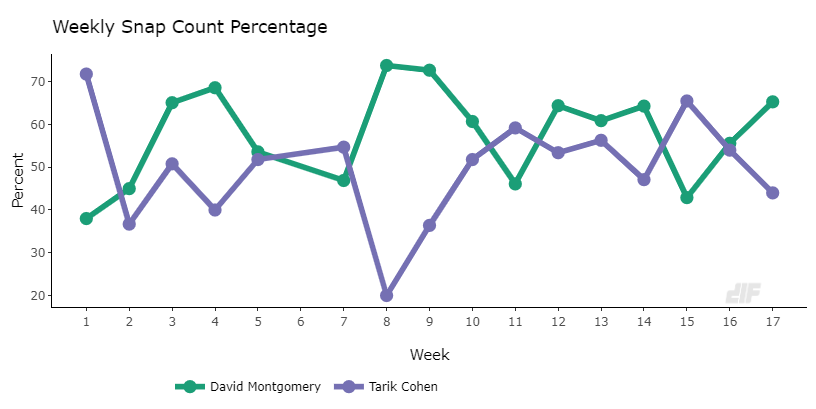
Breaking it down even deeper and looking into the fantasy points scored from week ten on, Montgomery – the 73rd pick in the 2019 draft – was actually outscored by his backfield counterpart by 25.8 points in PPR formats. Yet the former is being drafted at an ADP of 60.17 and RB22 – definitely some food for thought.
Borderline RB2 With RB1 Upside
By drafting the soon-to-be-fourth-year back, you are getting someone who already has an RB1 and two near RB2 finishes in just three years in the league. Looking at the player data app over at DLF, we see finishes of RB29, RB12, and RB27 respectively.

Let us also take into consideration that Jordan Howard was in town in 2018 when the Cohen grad had his RB1 finish. Howard managed to finish as the RB21 that season, proving the offense can support an RB1 and an RB2 in the same season.
The Nagy Factor
Perhaps the soon-to-be-third-year head coach gets back to the roots that made the Chicago Bears offense formidable (25.6 points per game – tenth) and a playoff team in 2018. There was steep regression in 2019 (17.5 PPG – 30th) and that dropped the Bears to an 8-8 record in 2019.
A throwback utilizing Montgomery in the Howard role and Cohen featured more in the passing game may be the recipe to return to offensive success in the Windy City. Matt Nagy has always had success in coaching the position. In his lone season as the Kansas City Chiefs offensive coordinator in 2017, Kareem Hunt finished as the RB4, despite being a rookie.

All of these factors point to 5’6”, 191-pound back Cohen returning to fantasy relevance in 2020. There is no need to worry about age either. Cohen will be just 25 years old when the season starts. Even if it does not play out as expected, it will not have cost you much to take the chance on the electric playmaker.
James White, RB NE (ADP: 127.00, RB43)
As mentioned earlier, White is a target monster. The New England Patriots passing down back has had 290 targets since 2017, trailing only the aforementioned McCaffrey and Kamara in that category at the position. The hesitancy is understandable with his “advanced” age of 28, but one would have to think there are still a couple of solid years of usage to be tapped here.
A Model of Consistency
You likely will not win a lot of weeks simply because you have White in your lineup, but you certainly will not lose many because of him. In 2019, double-digit scoring was achieved in all but three of the 15 games played. Despite playing in just 15 games, the Wisconsin grad managed an RB18 finish.
It is easy to forget White was the RB6 in 2018. A look at the weekly position finishes chart show just how steady the RB2 finishes piled up every week.

Opportunity Knocks
White makes the most of his receiving opportunities while on the field. In 2019, the ratio was actually better than that of McCaffrey and in 2018 it was neck and neck with Kamara. The Patriots obviously trust him as a receiving threat out of the backfield and that will not change much even if Damien Harris finds his way on to the field in 2020. Sony Michel only saw 12 targets last season so he will be relegated to his typical goal line and short-yardage situations. The point per receiving opportunity chart illustrates how good White has been the past three seasons.
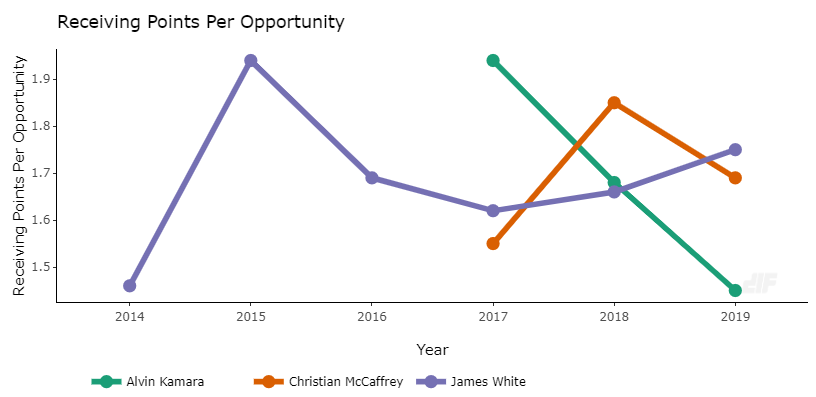
Deep Discount
A lot of comparisons have been made to McCaffrey and Kamara. Is he close to the caliber of a player like them? Of course not. Can you get him a steep discount if you miss out on the others early on? You sure can. A look at the finishes over the past three seasons is not indicative of what the ADP tells us. As mentioned, age is a concern, but at the price, it is not a concern at this stage of the game.
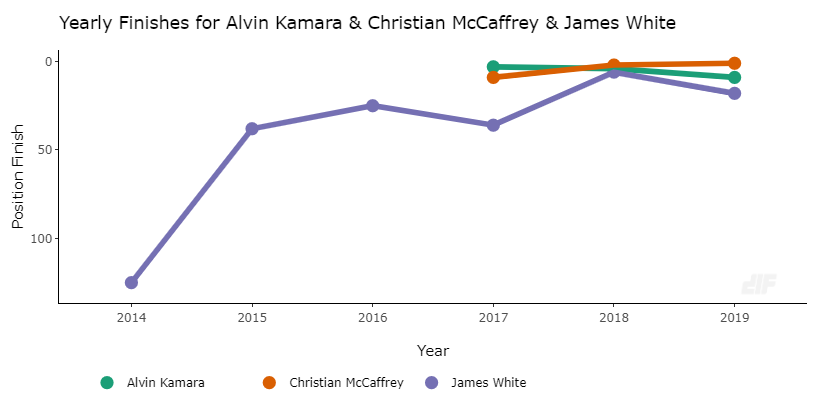
Jordan Howard, RB MIA (ADP: 148.33, RB51)
Up next, we have the often forgotten and always underrated Jordan Howard. Remember, the former Chicago Bears and Philadelphia Eagles rusher will still be just 26 years old when the 2020 season kicks off. While soon to be on his third team in five seasons, the journeyman running back has always quietly put up solid numbers.
Getting the Job Done
Howard has compiled an RB1 and two RB2 seasons during his four years in the league. While the numbers will not win you a fantasy championship, they are serviceable for a second running back, flex or bye week fill in. Howard has averaged over double-digit points every year in the league. While there has been a steady yearly decline, you still get production here. Using the average points per game chart available through the yearly data app, we get a better look at it.
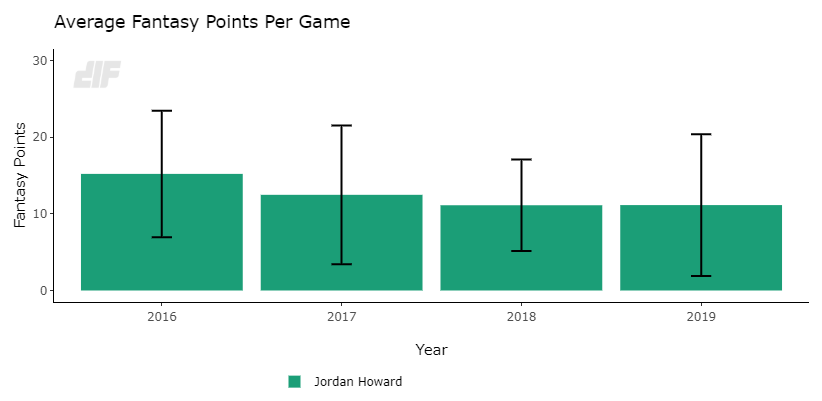
The 2019 Year in Review
Last season was the worst of Howard’s career. However, it is not all doom and gloom or a sign that the end is near. The Eagles only got seven meaningful games worth of snaps from him before basically shutting down the 2019 season with a shoulder injury during the week ten bye. From week three to week nine, however, the usually durable running back checked in as the RB11 during that timeframe (data courtesy of draftbuddy.com). Despite missing much of the season, the yearly data table again shows us that Howard still managed a respectable RB43 finish.

Prime Opportunity
Signing with the Miami Dolphins provides Howard with an opportunity to showcase his wares yet again. The Dolphins inked the former fifth-round pick to a two-year, $9.75 million contract on March 19th, 2020. It included $4.75 million guaranteed.
The only “real” competition that exists comes in the form of Matt Breida. The former San Francisco 49er tailback was acquired for the 153rd pick during the 2020 draft but has a hard time staying healthy. Breida has missed multiple games over the past two seasons, leaving his durability as a big question mark heading into the 2020 season.
Miami likely would not have made either of the two previous moves if they had any confidence in the in house options consisting of Kalen Ballage, Myles Gaskin, or Patrick Laird, thus potentially opening the door for Howard to take the lead back role in 2020. A look at the point per rushing opportunity chart shows exactly why he should be considered the leader in the clubhouse.
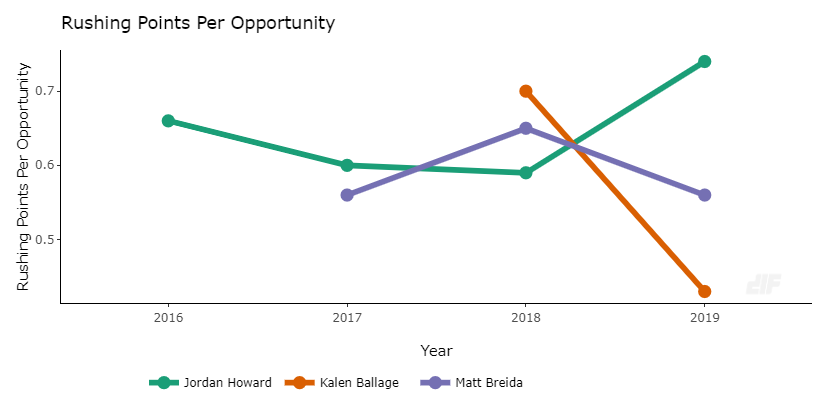
Wrapping it Up
Do not panic if you miss out on one of the few top running backs available early on in your draft. Your team is not destined for failure. The chance is still there to draft a more than capable fantasy running back in later rounds.
The running back position is thin compared to the wideouts. Load up on them and grab some upside players late. These are just a few I found who stood out to me. Be active on the wire and with trades and you will be well on your way to a championship.
Thank you for reading part two of this series. Up next will be the wide receiver position. I hope you enjoyed reading and look forward to having you back for part three. Feel free to comment and I will be glad to respond or hit me up on Twitter (@FFJeffSmith).
- A View From The 1.XX Series Recap - April 24, 2024
- 2024 Coaching Changes: The Dynasty Impact of Antonio Pierce to the Las Vegas Raiders - April 19, 2024
- 2024 Coaching Changes: The Dynasty Impact of Dave Canales to the Carolina Panthers - March 24, 2024


































































